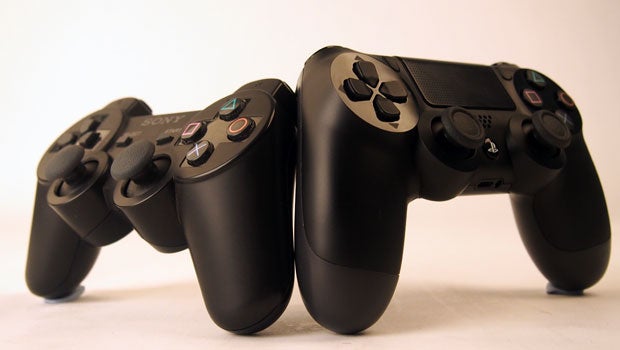1. Face Buttons (Cross, Circle, Square, Triangle)
- DS3: Pressure-sensitive, meaning the controller can detect how hard you press the buttons (ranging from light tap to hard press). This allows for variable actions, especially in certain PS2/PS3 games.
- DS4: These buttons are digital (on/off) and no longer pressure-sensitive. They detect only whether a button is pressed, not how hard it’s pressed.
2. Shoulder Buttons (L1, R1)
- DS3: Digital and respond with simple on/off presses.
- DS4: Remain digital, but their size and positioning are improved for better ergonomics and response.
3. Trigger Buttons (L2, R2)
- DS3: Pressure-sensitive (analog), detecting the force applied to them, which allows for more control over actions like acceleration in racing games.
- DS4: Also pressure-sensitive (analog), but the trigger buttons are more pronounced and provide more travel and feedback, improving their use in shooters, driving games, etc.
4. D-Pad (Directional Buttons)
- DS3: Pressure-sensitive and designed with a separated layout.
- DS4: Digital-only. The layout remains largely the same, but the D-pad is a bit firmer, with a more responsive feel due to the new sensors.
5. Analog Sticks (Left Stick and Right Stick)
- Both: The sticks on both the DS3 and DS4 are analog, meaning they can detect varying degrees of movement.
- DS4: Sticks are improved for better grip with a concave surface (the DS3 sticks are convex), which helps prevent slipping.
6. Start/Select vs Options/Share
- DS3: Features
StartandSelectbuttons. - DS4: Replaces them with the
Optionsbutton (combines both functions) and theSharebutton, which is used for capturing screenshots and video or streaming gameplay.
7. Home (PS Button)
- Both: Both have a PS button used to bring up the system menu. However, the DS4 PS button is larger and more centrally located.
8. Touchpad (DS4 Only)
- DS4: Adds a multi-touch touchpad in the center of the controller, which can be used for swiping gestures, clicking, and other in-game functions. The DS3 does not have this feature.
9. Sixaxis and Motion Sensors
- DS3: Comes with Sixaxis motion-sensing technology, which allows for tilt-based controls.
- DS4: Improves upon this with a more accurate motion sensor and adds a gyroscope and accelerometer for more precise motion tracking.
10. Light Bar (DS4 Only)
- DS4: Features a light bar on the back of the controller, which can change colors based on player position, health status, and in-game events. The DS3 does not have this feature.
11. Speaker and Headphone Jack (DS4 Only)
- DS4: Includes a built-in speaker and 3.5mm headphone jack for enhanced audio experiences in some games.
- DS3: Lacks these features entirely.
12. Vibration
- DS3: Uses a dual motor rumble feature, providing force feedback for in-game events.
- DS4: Improves on the rumble feature, offering a more refined and responsive vibration experience.
Summary of Major Differences:
- Pressure Sensitivity: DS3 has pressure-sensitive face buttons and triggers, whereas the DS4 only has pressure-sensitive triggers (L2/R2).
- Touchpad & Light Bar: DS4 adds a touchpad and light bar for enhanced gameplay features.
- Ergonomics: The DS4 controller has a more refined ergonomic design with better-placed triggers and sticks.
When using BlueRetro with DualShock 3 (DS3) and DualShock 4 (DS4) controllers on the PS2, the L2 and R2 pressure-sensitive functionality can be a bit different compared to the original PS2 DualShock 2 controller, which supported full analog pressure sensitivity on all buttons.
Here’s how it works:
1. PS2 Pressure-Sensitive Buttons:
- The PS2 DualShock 2 controller has pressure-sensitive buttons, including L1, L2, R1, and R2. Some PS2 games take advantage of this by allowing variable input based on how hard you press these buttons (e.g., accelerating slowly in racing games).
2. DS3 (DualShock 3) and DS4 (DualShock 4) Controllers:
- The DS3 supports pressure-sensitive buttons, including L2 and R2, which means it can closely mimic the functionality of the DualShock 2 on the PS2 when used with BlueRetro.
- The DS4, however, does not have pressure-sensitive face buttons or triggers like the DS2 and DS3. Instead, the L2 and R2 triggers on the DS4 are treated as digital inputs (fully on or fully off) when mapped to the PS2.
3. BlueRetro and Pressure Sensitivity:
- With DS3: The L2 and R2 triggers on the DS3 retain their pressure-sensitive functionality when paired with BlueRetro, allowing you to use games that require this feature.
- With DS4: Since the DS4 lacks pressure sensitivity, BlueRetro cannot replicate this feature for L2 and R2. They will behave as binary inputs (fully pressed or not pressed) rather than allowing for gradual pressure input.
4. Games Affected by This:
- Racing games (like Gran Turismo or Burnout) and some action games (Metal Gear Solid 2/3) are examples where pressure sensitivity might be needed.
- If you’re using a DS4 and require pressure sensitivity for a particular game, switching to a DS3 or original DualShock 2 controller is recommended.
5. Potential Workaround:
- No true workaround exists for adding pressure sensitivity to the DS4’s triggers. However, for games where it matters, you can use the DS3 or DualShock 2 via BlueRetro to maintain that analog functionality.
In summary:
- DS3: You’ll get full L2 and R2 pressure sensitivity with BlueRetro on the PS2.
- DS4: You’ll lose that pressure sensitivity, as the DS4 lacks this feature.
